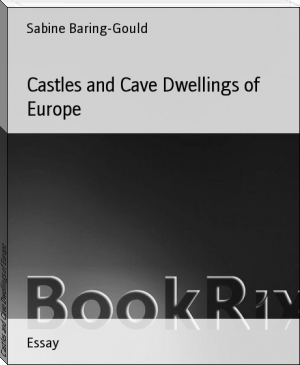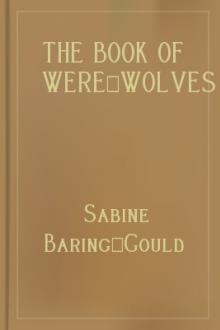Castles and Cave Dwellings of Europe by Sabine Baring-Gould (best ereader for pc .TXT) 📕

- Author: Sabine Baring-Gould
Book online «Castles and Cave Dwellings of Europe by Sabine Baring-Gould (best ereader for pc .TXT) 📕». Author Sabine Baring-Gould
The notion of suspended animation after death by no means expired with paganism. When Severus, Bishop of Ravenna, was about to die, he went in full pontificals to the tomb of his wife and daughter, had the stone removed, and bade the dead ones make room for him between them, and they obeyed. When S. Meven died, and his faithful friend Austell followed him shortly after, the dead body moved on one side in the sarcophagus to accommodate his companion. When an irreverent man struck the coffin of S. Cadoc with a staff, the incensed Saint "roared like a bull." In the Life of S. Germanus of Auxerre is a curious episode. A pagan named Mamertinus being overtaken by night and a storm, took refuge in a solitary building in which was a sarcophagus. He put his knapsack under his head on the upper slab of the tomb, and lying down there went to sleep. At midnight he was roused by a young man at the door of the cell, who called out, "Corcodemus, Corcodemus, levite of Christ, arise!" whereupon a voice answered from the tomb, "What do you want?" The youth replied, "Bishop Perigrinus and Bishop Amator want you at the church, where they are holding vigil." "I can't go," replied the dead man, "I have a visitor here and I must show him hospitality." After an interval the young man returned with two others and again summoned Corcodemus, who now got out of his grave and said to one of those who was at the door, "I will go with you, but you must abide here and protect my visitor, for there is a bitch with her young, to the number of seven, ready to tear him to pieces."
So late as 1680 a book appeared, _De Miraculis Mortuorum_, by L. C. F. Garmann, published at Leipzig, opposing opinions not merely of the ignorant but of the learned as to a kind of prolongation of physical life in the dead--their issuing from the graves to suck the blood of the living, their continuing their wonted avocations underground, as a shoemaker being heard cobbling in his coffin, of infants shedding their milk teeth and growing second teeth, of gnawing their grave clothes, and many other horrible superstitions--showing how persistent the belief was that the dead did continue to live in their sepulchres. [Footnote: The confusion between the ghost and the corpse is exemplified in "Hamlet."
"Tell
Why thy canoniz'd bones, hearsed in death,
Have burst their cerements; why the sepulchre,
Wherein we saw thee quietly inurn'd,
Hath op'd his ponderous and marble jaws
To cast thee up again."
Act I. sc. 5.]
The idea that by symbolic burial a man became regenerate, that he put off the old condition and entered into another that was new, by passing through the earth or a hole in the rocks, was very general, and it has continued to the present day in the modified form of enabling a sufferer by this means to leave behind his infirmities and pass into a condition of robust health, or of one charged with a crime clearing himself by this ordeal.
The passing of a child through the earth was forbidden by the Canons of Edgar (A.D. 969). [Footnote: Thorpe, "Ancient Laws and Institutes," Lond. 1840.] Women who had crying children dug a hole in the earth and thrust the child through, drawing it out at a further hole. Men were forbidden also to pass cattle through a hollow tree or _per terram foratam transire_. In France weak children were passed through a hollow stone of S. Tesse. In the crypt of Ripon Minster is a hole in the rock through which young women crept to establish their innocence when charged with incontinence. In Iceland a long turf was cut attached to the soil at both ends, and such as would pass out of a condition of hostility into one of brotherhood crawled through the gap. At Ilefeld, in the Harz, is a holed stone called the Nadeloehr. Any one coming to settle in the Harz for the first time is required to creep twice through the perforation. In a good many places in Germany a similar process is gone through to cure lumbago. Indra, the god of Thunder among the Hindoos, drew a sick man thrice through a hole, and thereby gave him health and new birth. The many Helfensteins that are found in Germany were in like manner stones of Help, by traversing which the old man was put off and the new man put on. [Footnote: Sepp, _Altbayerischer Sagenschatz_, Munich, 1876, p. 87 _et seq_.] Creeping through a holed stone, or under one suspended over another, is still practised in Ireland as a cure for disorders. From passing under the earth the custom passed to going through a split tree, the tree representing the coffin. An interesting account of this usage will be found in White's "Selborne."
And now let us turn to something else.
A religion of the worship of ancestors formed the ground-work of many religions that in process of time have totally changed their character. It lies at the root of the creeds and practices of most peoples in east and west. It was in Greece before its religion passed into the stage of the deification of natural forces. The Assyrians and Chaldeans clung to it in Western Asia. The Egyptians in the valley of the Nile, the Etruscans in Italy. At the other extremity of the world, the Chinese and Anamites perform its rites to this day from Saghalien to Cambodia.
But in Western Asia and in Europe the primitive religion became modified little by little. On the borders of the Tigris and the Euphrates, as well as on the banks of the Nile, appeared the beginnings of a different eschatology and a vague expectation of a resurrection of the dead. The Hellenes and Romans, under the influence of philosophy, acquired another conception of immortality, and their institutions, issuing from collectivism, broke up into individualism.
In the extreme East, on the other hand, the ancient beliefs and institutions remained stationary, and Buddhism was unable materially to disturb them. It introduced its doctrine of Metampsichosis, its Nirvana, and its hell; but these notions did not modify, they got mixed up with the old conceptions in a jumble of heterogeneous and contradictory beliefs. To the present day the family remains the unit in the State; it is under the patriarchal despotism of the head of the line, the priest of the domestic hearth, the proprietor for the time being of the family estate. Every household has its particular gods and protectors--the ancestors thus sublimated, and the master of the family, the prospective god. The condition beyond the grave in no way depends on conduct during life, it is determined by the descendants. If the defunct be honoured, enriched with sacrifices, he becomes a beneficent protector and is happy; neglected and abandoned, he avenges his unfortunate condition on his forgetful posterity. To transmit the family cult and the patrimonial field to an heir is the first duty of man. We inherit unconsciously, not the physical character of our ancestors only, but also their ideas and prejudices. Our practices are often dictated by custom of very ancient date, not at all by reason or by conviction. Expense and trouble are incurred to convey a corpse from one end of Europe to England, that it may repose in the family vault. We decorate our graves with flowers as though the dead appreciated them; they are but the representatives of the ancient sacrifice to the dead. We drink to the memory of the deceased as though pouring out libations to them. Our tombstones are direct descendants of the menhir and the obelisk, our altar-tombs of the dolmen, our family vault of the primeval cave ossuary.
But in one point we have diverged very far from the path of old beliefs. We have lost touch with the invisible world; we put our dead out of sight and remember them no more, as though no part of the community to which we belong, nor links in a chain of which every link is living.
It was one of the sayings of Swedenborg, that the Aryan West had something to learn from the Turanian East. It is so--the reverend thought of the dead as still forming a part of the organism of the family. With the revolt at the Reformation at the trade made out of the feelings of the bereaved, the coining of their tears into cash to line the pockets of the priests, came an unwarranted oblivion of the dead, a dissociation from them. The thought that the departed had still a claim on our sympathy and on our prayers was banished as smacking of the discarded abuse. Prayer for the dying was legitimate and obligatory at ten minutes to three, but prohibited at five minutes to three when the breath had passed away. We have gone too far in this direction. We live in an immaterial as well as in a material world. We are planted at the overlap of two spheres, that which is spiritual and that which is physical, and we gravitate so sensibly and so rapidly to the latter as to lose touch with the former, and finally to disbelieve in the existence of such a sphere.
The earth can radiate its heat, and receive and be steeped in the falling dew only when the sky is not overcast; but our heavens are so thick with clouds that our spirits can exhale no warmth into the Infinite, nor drink in any balm descending from the Unseen. It is only by detachment from the routine of vulgar life that we can enter into any relation with the spiritual world. Political interests, social obligations, financial concerns, choke the spiracles of our inner being, and we lose all concern about what is supersensible, and hold no communication with it. There are stars and planets overhead, Orion with his spangled belt, Cassiopeia in her glittering chair, and Pleiades in their web of silver, but we cannot see them because of the fog that envelops us.
According to an Indian legend, the first men were bred like maggots in the heart of the earth, but laying hold of some depending fibres drew themselves up into the light of day. We reverse the order, and from the bright spiritual sphere crawl underground by the thousand tendrils of daily life.
The early Methodists and the Quakers broke away from the low material conception of life common in their day, and asserted the reality of the spiritual world, and the duty of living for it, as also the certainty of holding intercommunion with the spirits. The 'Other worldliness' of the mediaeval monastic mysticism had produced a revolt against a conception of life that was false, its passive hostility to civilisation, the hollowness of its ideal existence, its exaggerated asceticism, its disparagement of the family life, and the result was the swing of the pendulum in the opposite direction. The recoil came with the Methodists. But we cannot live wholly in the world of spirit, any more than we ought to live wholly in the world of matter, for our nature is double, and no portion of it should be atrophied. Extreme mysticism is as falsifying of our nature as is extreme worldliness. The stupidity and charlatanism of modern spiritualism is the rebellion of men and women against the materialism of present conception of life. Where natural expression of a need is checked, it breaks out in a disordered form, just as arrested perspiration and circulation of the blood produce fever.





Comments (0)